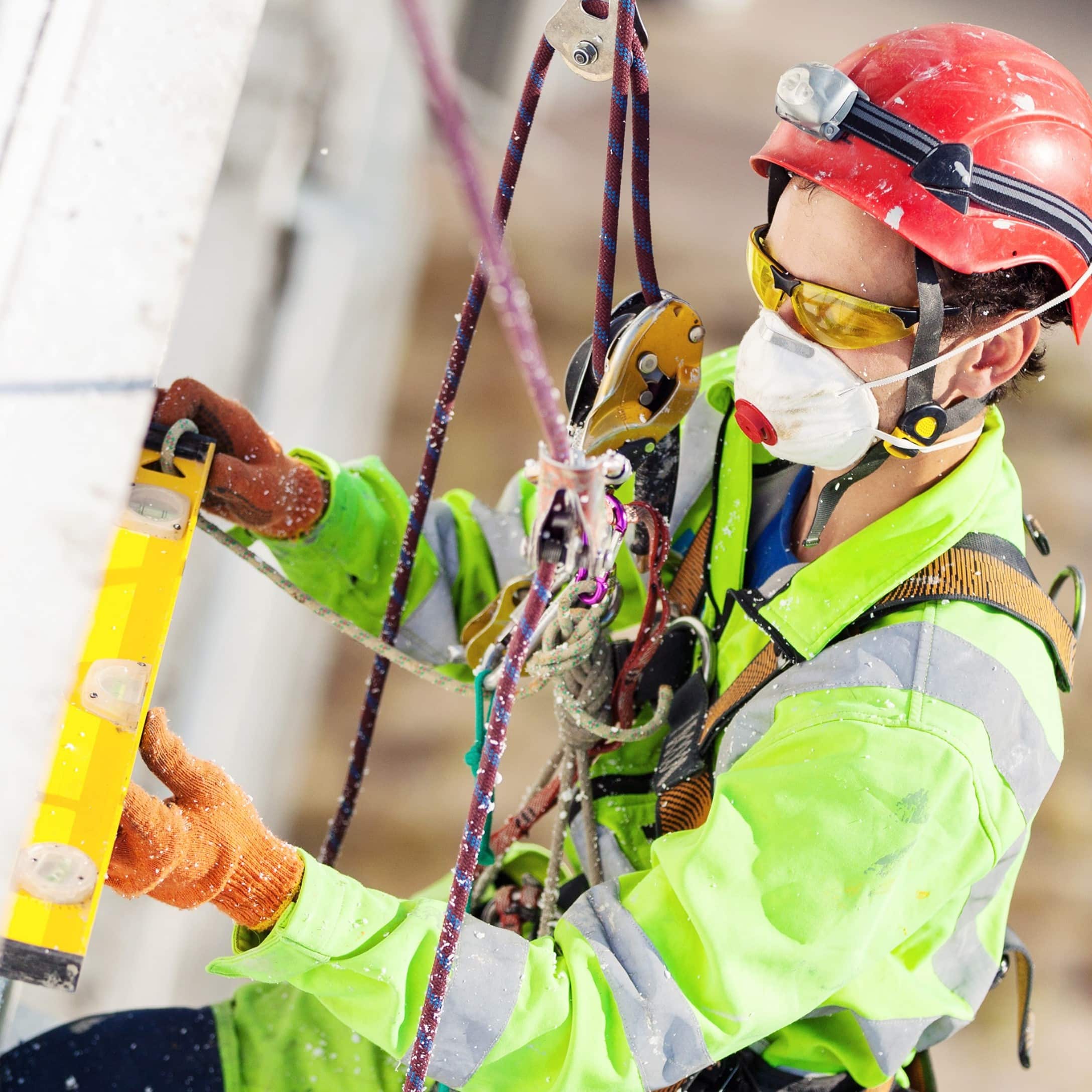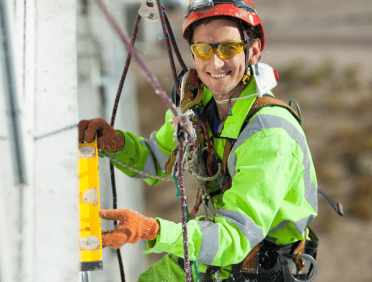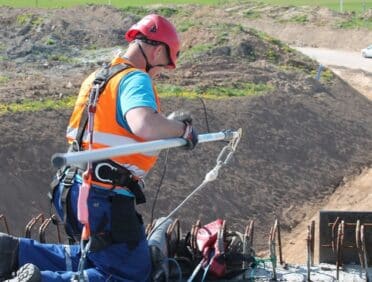What is the meaning of working at height?
Working at height refers to any work on, below, or above ground level where there is a risk of personal injury through falling. It is not only about the actual height at which the work is performed but also concerns the potential distance one could fall. This means work at height can happen at or below ground level if a person could fall from an edge, through an opening, or from a surface that is fragile, leading to personal injury. The UK’s Health and Safety Executive (HSE) emphasizes that a risk assessment should be the first step in determining the necessary precautions for work at height, focusing on avoiding falls and mitigating the distance and consequences of a fall should one occur.
What is the minimum height for working at height in the UK?
In the UK, there is no defined minimum height in the regulations concerning working at height. The Work at Height Regulations 2005 apply to all work at height where there is a risk of a fall liable to cause personal injury, regardless of the height. This approach is based on the risk of falling rather than the height itself. Therefore, even tasks performed at ground level or below that involve a risk of falling from an edge or through an opening must be considered under these regulations.
What is the 2 metre rule for working at height?
The 2 metre rule is a common misconception in the context of working at height in the UK. It suggests that work at height regulations apply only when working above 2 metres. However, the Work at Height Regulations 2005 make no such distinction. These regulations apply to any height where there is a risk of a fall causing personal injury. This means that tasks performed below 2 metres, where there is a risk of injury from a fall, are also covered by the regulations.
Do I need to be trained to work at heights?
Yes, training is crucial for anyone working at height. The Work at Height Regulations 2005 mandate that employers ensure all personnel involved in work at height are competent to do so. This includes having the necessary skills, knowledge, and experience. Training should cover risk assessment, the use of necessary equipment, and emergency procedures. It’s not just about knowing how to perform the tasks safely but also understanding the potential risks and how to mitigate them.
What are the hazards of working at height?
Hazards of working at height include falls from edges, through fragile surfaces, or into openings in floors and walls. These hazards can lead to serious injuries or fatalities if proper safety measures are not in place. Factors contributing to these hazards include inadequate training, poor weather conditions, unsuitable or incorrectly used equipment, and failure to follow safe working practices. It’s essential to conduct a thorough risk assessment and implement control measures such as guardrails, safety nets, or personal fall protection systems to mitigate these risks.
What is the maximum height at which you can work from a ladder?
There is no specific maximum height for working from a ladder stated in the UK regulations. However, the Work at Height Regulations 2005 require that ladders should only be used for work at height if a risk assessment has determined that the use of more suitable work equipment is not justified because of the low risk and short duration of use or existing workplace features that cannot be altered. When using a ladder, it’s crucial to ensure it is stable, secure, and suitable for the task, and that the work can be done safely.
At what height is a harness required?
The requirement for a harness is not determined by a specific height but by the risk assessment of the work being undertaken. If the assessment identifies a risk of falling and the distance of potential fall could cause injury, then personal fall protection equipment, such as a harness, may be required. This is part of the hierarchy of control measures where the preference is to first try to eliminate the risk of falling, then prevent falls with equipment like guardrails, and finally, to minimise the distance and consequences of a fall with fall arrest systems, including harnesses.
How many points of contact does a ladder have?
When using a ladder, the general safety guideline is to maintain three points of contact at all times to ensure stability and support. This means two hands and one foot or two feet and one hand should be in contact with the ladder at all times. This practice helps to prevent slips and falls by ensuring the person climbing the ladder has sufficient grip and stability.
What PPE is required for working at heights?
Personal Protective Equipment (PPE) required for working at heights can include helmets to protect against head injuries, harnesses for fall arrest, and non-slip footwear to prevent slips on ladders or elevated surfaces. The specific PPE required depends on the risk assessment of the task and work environment. It’s crucial that all PPE is correctly fitted, regularly inspected, and used properly to ensure worker safety.
What is the first rule for working at height?
The first rule for working at height is to avoid working at height where it is reasonably practicable to do so.
This means considering whether the task can be completed safely from the ground or a solid structure. If work at height is unavoidable, then the next steps involve using work equipment or other measures to prevent falls, followed by measures to minimise the distance and consequences of a fall should one occur.
What are the three common causes of accidents when working at height?
The three common causes of accidents when working at height are falls from edges, falls through fragile surfaces, and falls from ladders or scaffolding. These accidents often occur due to insufficient risk assessments, inadequate use or absence of safety equipment, and lack of training or competency among those working at height.
What are five examples of working at height?
Examples of working at height include:
1. Working on a roof to repair or install equipment.
2. Using a ladder to access high shelves in a warehouse.
3. Working on scaffolding during construction or maintenance of buildings.
4. Using a cherry picker or mobile elevated work platform for window cleaning or tree trimming.
5. Working in a harness to perform tasks on the exterior of tall structures, such as bridges or towers.
What does Riddor stand for?
RIDDOR stands for Reporting of Injuries, Diseases and Dangerous Occurrences Regulations. It is a UK statutory instrument that requires employers, self-employed individuals, and those in control of work premises to report certain serious workplace accidents, occupational diseases, and specified dangerous occurrences (near misses) to the relevant authorities.
What is the HSE guidance on working at height?
The HSE (Health and Safety Executive) provides comprehensive guidance on working at height, focusing on planning, risk assessment, and selecting the right equipment for the job. The guidance emphasises avoiding work at height where possible, using work equipment or other measures to prevent falls where work at height cannot be avoided, and where the risk cannot be eliminated, using equipment to minimise the distance and consequences of a fall.
What must employees do when working at height?
Employees must take reasonable care of themselves and others who may be affected by their actions. They should follow the training and instructions provided for working at height. This includes properly using any safety equipment provided, reporting any hazards or unsafe conditions, and not interfering with or misusing anything provided for health, safety, or welfare.
What is the HSE definition of working at height?
The HSE defines working at height as work in any place where, if precautions were not taken, a person could fall a distance liable to cause personal injury. This includes work above ground/floor level, near an edge through which a person could fall, near an opening in the floor, or near a fragile surface that could give way.
What is the 6 foot ladder rule?
The 6-foot ladder rule typically refers to OSHA (Occupational Safety and Health Administration) standards in the United States, specifying that fall protection is required when working at heights of 6 feet (about 1.8 meters) or more in the construction industry. However, in the UK, the Work at Height Regulations do not specify a 6-foot rule, focusing instead on the risk of falling and the measures to prevent or minimise injury from falls.
How long can you legally work on a ladder?
UK regulations do not specify a fixed time limit for working on a ladder. Instead, the Work at Height Regulations require that ladders should only be used for short-duration work or where the risk is low, and the task involves light work. The duration should be assessed as part of the risk assessment process, considering the task, the individual’s fitness and capability, and the equipment used.
Should you wear a harness on scaffolding?
Whether a harness is required on scaffolding depends on the risk assessment and the design of the scaffolding. If the scaffolding is correctly erected with guardrails and toe boards, and the risk assessment determines it is safe, then a harness may not be required. However, in situations where there is a risk of falling, such as incomplete or free-standing scaffolding, a harness may be necessary as part of the fall protection system.
What are the main causes of falls from heights?
The main causes of falls from heights include lack of or improper use of fall protection equipment, slips and trips, unsafe work practices, unstable working surfaces, and failure to follow safety procedures. Adequate training, proper planning, and the correct use of safety equipment are essential to prevent these incidents.
Can my employer force me to work at heights?
Employers have a duty to ensure the safety of their employees and cannot force them to work in unsafe conditions. Employees should be adequately trained and competent to work at height, and the work should be planned and carried out safely, in accordance with the Work at Height Regulations. If an employee feels unsafe, they should report this to their employer.
What does Puwer stand for?
PUWER stands for the Provision and Use of Work Equipment Regulations. These UK regulations are designed to ensure that all work equipment, including equipment used for working at height, is suitable for its intended purpose, safely installed and maintained, and used only by people who have received adequate training.
When should you use a ladder?
A ladder should be used when work at height cannot be avoided but the task is short duration and involves light work. The decision to use a ladder should be justified through a risk assessment, ensuring the ladder is the most suitable piece of equipment for the task, and that its use presents a lower risk compared to other options.
What kind of hazard is falling from heights?
Falling from heights is a physical hazard that poses significant risks, including serious injuries or fatalities. This type of hazard is prevalent in various industries, particularly construction, maintenance, and window cleaning. Effective risk management, including proper planning, training, and use of safety equipment, is essential to mitigate the risks associated with working at height.
What height is considered working at height in the UK?
In the UK, there is no specific height that defines ‘working at height.’ Instead, it is any work in any place where, if precautions were not taken, a person could fall a distance liable to cause personal injury. This includes work above ground level, near an edge, near an opening, or near a fragile surface.
What are the most common hazards of working at height?
The most common hazards of working at height include falls from edges, through openings, off ladders, and through fragile surfaces. These hazards can lead to serious injuries or fatalities if proper safety measures, such as risk assessments, use of appropriate safety equipment, and adherence to safe working practices, are not implemented.
Working at Height Training
- The Working at Height (£17.50) course offered by Learn Q is designed to educate individuals on the safe practices and regulations for working at various heights, including both above and below ground level. It covers the essentials of working in compliance with the Work at Height Regulations 2005, aiming to prevent injuries and thereby reduce costs related to workplace accidents. The course content includes understanding the requirements for working at height, relevant legislation, proper use of work equipment, and safe ladder use. This online course is CPD accredited and takes approximately 1-2 hours to complete.
You can get further savings by purchasing one of Learn Q’s Money Saving Bundles, such as:
These courses are designed to provide comprehensive training on health and safety in trade and construction environments. They cover key aspects like risk assessment, regulations, and safe work practices. The bundle is aimed at employees in trade or construction roles and is suitable for both new starters and as refresher training. The courses are delivered online, can be completed at the learner’s pace, and upon completion, certificates are immediately available for download.
At Learn Q, we are dedicated to delivering top-tier training tailored for professionals in various sectors, focusing on essential safety protocols. The Working at Height course equips you with crucial knowledge and practical skills for safe operations in elevated environments, ensuring you and your colleagues can make a significant impact on workplace safety.












